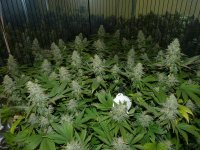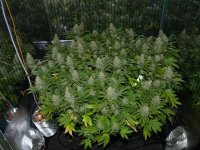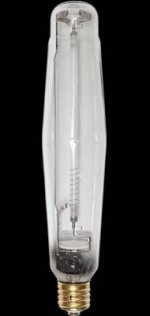I posted this in another topic, but I thought it had enough value to stand on its own to keep the discussion more focused in the other topic.
So sorry for the cross-post but I think it deserves a separate topic.
These measurements were done using a calibrated Ulbricht sphere and a high frequency electronic ballast that was modified to tune the output to the exact value optimal for the lamp tested. Some lamps did not reach their full power on the used ballast, so in order to make a fair comparison we tuned the output of the ballast to every individual lamp so all lamps got exactly the same power. This means that though this is a fair comparison for the lamps (they all received exactly the same energy) it is not a guarantee that these values will be reached in any other ballast, as different ballasts / lamp combinations result in different output powers. Ballast losses were not calculated because every ballast has different losses.
If you measure the energy used (W, not amps!) by your ballast and it is less than the manufacturer specified value, that is an indication that the output specified is not reached (if the ballast manufacturers specifications were correct!).
Every lamp manufacturer or light lab that has a calibrated Ulbricht sphere, a high frequency tune-able ballast and a high frequency power analyzer can repeat these measurements for verification.
These were all new lamps, sourced from our distributors and some just bought in shops.
So here's something for the weekend to study. As you see the difference can be a stunning 30% more light using a different lamp and even more with a ballast that is tuned to the lamp.

I do hope this will motivate other lamp suppliers to publish their specifications in ppf so they can be compared.
We also have tests on the way for light maintenance but as you can imagine those take a while (6 months to a year to be exact).
These are not all 1000W lamps available on the US market, but the ones we have available for testing at the moment. Of course there can be individual tolerances or batch differences and that's why we have more than one lamp of each.
We underran and overran the lamps on different powers as modern electronic ballasts can be adjusted too, and to show what this does with efficiency. The 1000DE is still very decent at 600W, but a 600W 400V Philips EL is still 15% more efficient at 600W. You see that some lamps do not come to their optimal efficiency, some are very close to it. You also see that efficiency can be even higher when you boost a lamp. Agreed, you spend more on electricity and it will cause your lamp to wear out a bit earlier maybe, but who uses his lamps 20.000 hours (4 years!)? And you still have a better efficiency and more light, even if the lamp loses 5% per year it's 10% more light when you boost 15%.
The power delivered to each lamp was very accurate as we had full control of the ballast output. Test equipment is described in my previous ballast test topic.
So sorry for the cross-post but I think it deserves a separate topic.
Earlier I promised to share with you our measurements in the Ulbricht sphere of some common North American lamps compared to our 1000W double ended Philips and our own Gavita single ended lamp.
These measurements were done using a calibrated Ulbricht sphere and a high frequency electronic ballast that was modified to tune the output to the exact value optimal for the lamp tested. Some lamps did not reach their full power on the used ballast, so in order to make a fair comparison we tuned the output of the ballast to every individual lamp so all lamps got exactly the same power. This means that though this is a fair comparison for the lamps (they all received exactly the same energy) it is not a guarantee that these values will be reached in any other ballast, as different ballasts / lamp combinations result in different output powers. Ballast losses were not calculated because every ballast has different losses.
If you measure the energy used (W, not amps!) by your ballast and it is less than the manufacturer specified value, that is an indication that the output specified is not reached (if the ballast manufacturers specifications were correct!).
Every lamp manufacturer or light lab that has a calibrated Ulbricht sphere, a high frequency tune-able ballast and a high frequency power analyzer can repeat these measurements for verification.
These were all new lamps, sourced from our distributors and some just bought in shops.
So here's something for the weekend to study. As you see the difference can be a stunning 30% more light using a different lamp and even more with a ballast that is tuned to the lamp.
I do hope this will motivate other lamp suppliers to publish their specifications in ppf so they can be compared.
We also have tests on the way for light maintenance but as you can imagine those take a while (6 months to a year to be exact).
These are not all 1000W lamps available on the US market, but the ones we have available for testing at the moment. Of course there can be individual tolerances or batch differences and that's why we have more than one lamp of each.
We underran and overran the lamps on different powers as modern electronic ballasts can be adjusted too, and to show what this does with efficiency. The 1000DE is still very decent at 600W, but a 600W 400V Philips EL is still 15% more efficient at 600W. You see that some lamps do not come to their optimal efficiency, some are very close to it. You also see that efficiency can be even higher when you boost a lamp. Agreed, you spend more on electricity and it will cause your lamp to wear out a bit earlier maybe, but who uses his lamps 20.000 hours (4 years!)? And you still have a better efficiency and more light, even if the lamp loses 5% per year it's 10% more light when you boost 15%.
The power delivered to each lamp was very accurate as we had full control of the ballast output. Test equipment is described in my previous ballast test topic.







